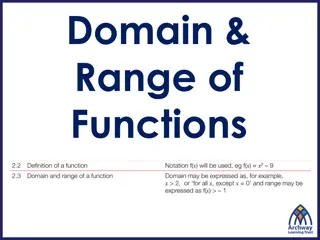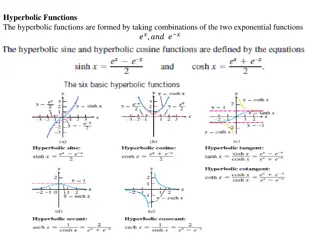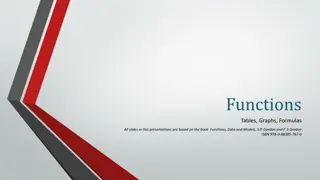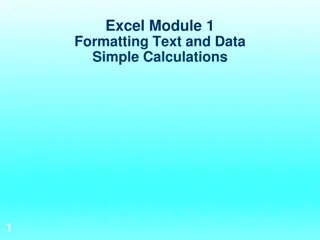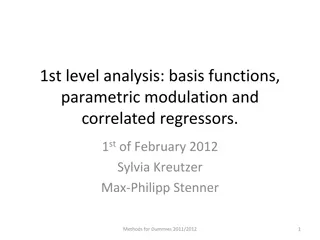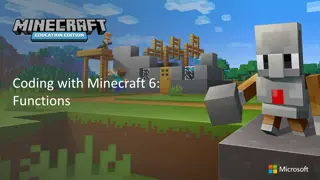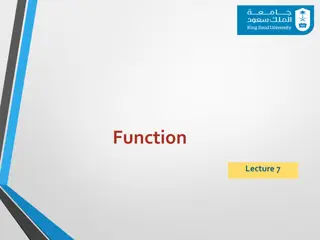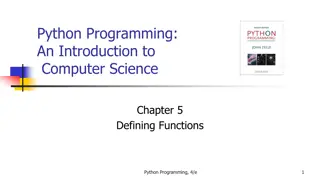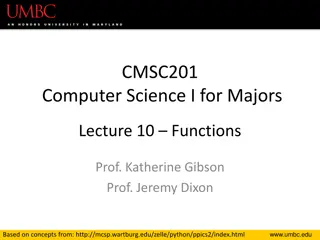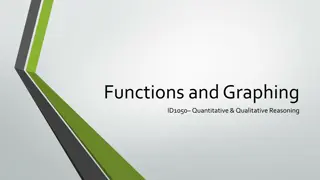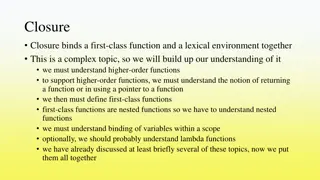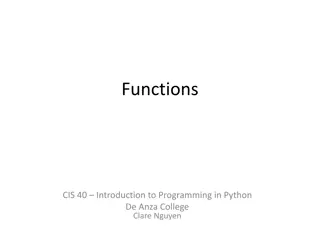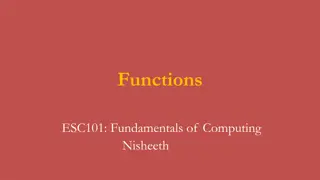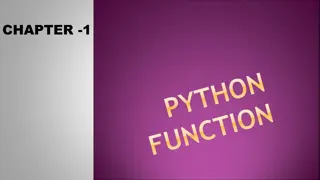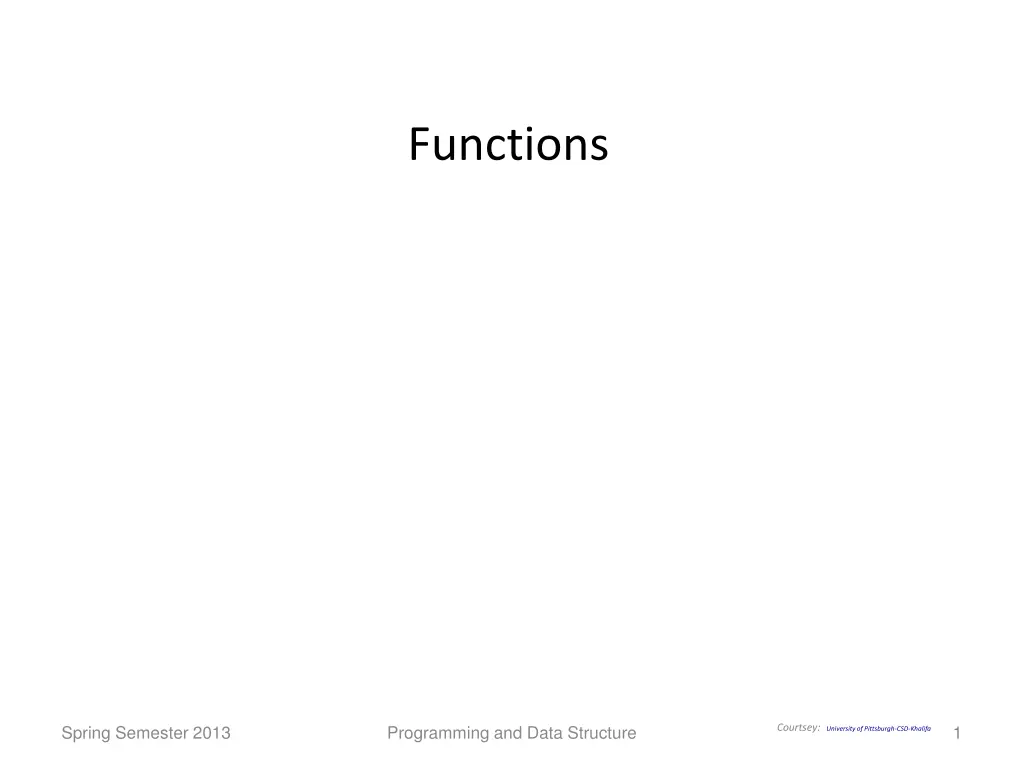
Understanding C Programming Functions: Benefits and Definitions
Explore the concept of functions in C programming, including their benefits, how they modularize programs, communicate information between functions, and the process of defining a function with return types and parameters.
Download Presentation

Please find below an Image/Link to download the presentation.
The content on the website is provided AS IS for your information and personal use only. It may not be sold, licensed, or shared on other websites without obtaining consent from the author. If you encounter any issues during the download, it is possible that the publisher has removed the file from their server.
You are allowed to download the files provided on this website for personal or commercial use, subject to the condition that they are used lawfully. All files are the property of their respective owners.
The content on the website is provided AS IS for your information and personal use only. It may not be sold, licensed, or shared on other websites without obtaining consent from the author.
E N D
Presentation Transcript
Functions Courtsey: University of Pittsburgh-CSD-Khalifa Spring Semester 2013 Programming and Data Structure 1
Introduction Function A self-contained program segment that carries out some specific, well-defined task. Some properties: Every C program consists of one or more functions. One of these functions must be called main . Execution of the program always begins by carrying out the instructions in main . A function will carry out its intended action whenever it is called or invoked. Spring Semester 2013 Programming and Data Structure 2
In general, a function will process information that is passed to it from the calling portion of the program, and returns a single value. Information is passed to the function via special identifiers called arguments or parameters. The value is returned by the return statement. Some function may not return anything. Return data type specified as void . Spring Semester 2013 Programming and Data Structure 3
#include <stdio.h> main() { n, factorial (n) ); } int factorial (int m) { int i, temp=1; for (i=1; i<=m; i++) temp = temp * i; return (temp); } int n; for (n=1; n<=10; n++) printf ( %d! = %d \n , Spring Semester 2013 Programming and Data Structure 4
Functions: Why? Functions Modularize a program All variables declared inside functions are local variables Known only in function defined Parameters Communicate information between functions They also become local variables. Benefits Divide and conquer Manageable program development Software reusability Use existing functions as building blocks for new programs Abstraction - hide internal details (library functions) Avoids code repetition Spring Semester 2013 Programming and Data Structure 5
Defining a Function A function definition has two parts: The first line. The body of the function. return-value-type function-name ( parameter-list ) { declarations and statements } Spring Semester 2013 Programming and Data Structure 6
The first line contains the return-value-type, the function name, and optionally a set of comma-separated arguments enclosed in parentheses. Each argument has an associated type declaration. The arguments are called formal arguments or formal parameters. Example: int gcd (int A, int B) The argument data types can also be declared on the next line: int gcd (A, B) int A, B; Spring Semester 2013 Programming and Data Structure 7
The body of the function is actually a compound statement that defines the action to be taken by the function. int gcd (int A, int B) { int temp; while ((B % A) != 0) { temp = B % A; B = A; A = temp; } return (A); } BODY Spring Semester 2013 Programming and Data Structure 8
When a function is called from some other function, the corresponding arguments in the function call are called actual arguments or actual parameters. The formal and actual arguments must match in their data types. Point to note: The identifiers used as formal arguments are local . Not recognized outside the function. Names of formal and actual arguments may differ. Spring Semester 2013 Programming and Data Structure 9
#include <stdio.h> /* Compute the GCD of four numbers */ main() { int n1, n2, n3, n4, result; scanf ( %d %d %d %d , &n1, &n2, &n3, &n4); result = gcd ( gcd (n1, n2), gcd (n3, n4) ); printf ( The GCD of %d, %d, %d and %d is %d \n , n1, n2, n3, n4, result); } Spring Semester 2013 Programming and Data Structure 10
Function Not Returning Any Value Example: A function which only prints if a number if divisible by 7 or not. void div7 (int n) { if ((n % 7) == 0) printf ( %d is divisible by 7 , n); else printf ( %d is not divisible by 7 , n); OPTIONAL return; } Spring Semester 2013 Programming and Data Structure 11
Returning control If nothing returned return; or, until reaches right brace If something returned return expression; Spring Semester 2013 Programming and Data Structure 12
Function: An Example #include <stdio.h> Function declaration int square(int x) { int y; y=x*x; return(y); } Name of function Return data-type parameter void main() { int a,b,sum_sq; Functions called printf( Give a and b \n ); scanf( %d%d ,&a,&b); sum_sq=square(a)+square(b); Parameters Passed printf( Sum of squares= %d \n ,sum_sq); Spring Semester 2013 } Programming and Data Structure 13
Invoking a function call : An Example #include <stdio.h> int square(int x) { int y; y=x*x; return(y); } Assume value of a is 10 a 10 void main() { int a,b,sum_sq; 10 x printf( Give a and b \n ); scanf( %d%d ,&a,&b); * returns sum_sq=square(a)+square(b); 100 y printf( Sum of squares= %d \n ,sum_sq); } Spring Semester 2013 Programming and Data Structure 14
Function Definitions Function definition format (continued) return-value-type function-name(parameter-list) { declarations and statements } Declarations and statements: function body (block) Variables can be declared inside blocks (can be nested) Function can not be defined inside another function Returning control If nothing returned return; or, until reaches right brace If something returned return expression; Spring Semester 2013 Programming and Data Structure 15
An example of a function datatype Return Function name int sum_of_digits(int n) { int sum=0; while (n != 0) { sum = sum + (n % 10); n = n / 10; } return(sum); } Parameter List Local variable Expression Return statement Spring Semester 2013 Programming and Data Structure 16
Variable Scope int A; void main() { } A = 1; myProc(); printf ( "A = %d\n", A); Printout: void myProc() { int A = 2; while( A==2 ) } . . . -------------- A = 3 { int A = 3; printf ( "A = %d\n", A); break; } printf ( "A = %d\n", A); A = 2 A = 1 Spring Semester 2013 Programming and Data Structure 17
Function: Summary #include <stdio.h> main() is a function main() { int n; for (n=1; n<=10; n++) printf ( %d! = %d \n , n, factorial (n) ); } Calling a function Returned data-type parameter int factorial (int m) { int i, temp=1; for (i=1; i<=m; i++) temp = temp * i; return (temp); } Return statement Function name Local vars Self contained programme Spring Semester 2013 Programming and Data Structure 18
Some Points A function cannot be defined within another function. All function definitions must be disjoint. Nested function calls are allowed. A calls B, B calls C, C calls D, etc. The function called last will be the first to return. A function can also call itself, either directly or in a cycle. A calls B, B calls C, C calls back A. Called recursive call or recursion. Spring Semester 2013 Programming and Data Structure 19
Math Library Functions Math library functions perform common mathematical calculations #include <math.h> cc <prog.c> -lm Format for calling functions FunctionName (argument); If multiple arguments, use comma-separated list printf( "%.2f", sqrt( 900.0 ) ); Calls function sqrt, which returns the square root of its argument All math functions return data type double Arguments may be constants, variables, or expressions Spring Semester 2013 Programming and Data Structure 20
Math Library Functions double floor(double x) -- Get largest integral value less than x. double cos(double x) -- Compute cosine of angle in radians. double cosh(double x) -- Compute the hyperbolic cosine of x. double sin(double x) -- Compute sine of angle in radians. double sinh(double x) - Compute the hyperbolic sine of x. double tan(double x) -- Compute tangent of angle in radians. double tanh(double x) -- Compute the hyperbolic tangent of x. double exp(double x -- Compute exponential of x double fabs (double x ) -- Compute absolute value of x. double log(double x) -- Compute log(x). double log10 (double x ) -- Compute log to the base 10 of x. double pow (double x, double y) -- Compute x raised to the power y. double sqrt(double x) -- Compute the square root of x. double acos(double x) -- Compute arc cosine of x. double asin(double x) -- Compute arc sine of x. double atan(double x) -- Compute arc tangent of x. double atan2(double y, double x) -- Compute arc tangent of y/x. double ceil(double x) -- Get smallest integral value that exceeds x. Spring Semester 2013 Programming and Data Structure 21 http://www.cs.cf.ac.uk/Dave/C/node17.html#SECTION001710000000000000000
More about scanf and printf Spring Semester 2013 Programming and Data Structure 22
Entering input data :: scanf function General syntax: scanf (control string, arg1, arg2, , argn); control string refers to a string typically containing data types of the arguments to be read in; the arguments arg1, arg2, represent pointers to data items in memory. Example: scanf (%d %f %c , &a, &average, &type); The control string consists of individual groups of characters, with one character group for each input data item. % sign, followed by a conversion character. Spring Semester 2013 Programming and Data Structure 23
Commonly used conversion characters: c single character d decimal integer f floating-point number s string terminated by null character X hexadecimal integer We can also specify the maximum field-width of a data item, by specifying a number indicating the field width before the conversion character. Example: scanf ( %3d %5d , &a, &b); Spring Semester 2013 Programming and Data Structure 24
Writing output data :: printf function General syntax: printf (control string, arg1, arg2, , argn); control string refers to a string containing formatting information and data types of the arguments to be output; the arguments arg1, arg2, represent the individual output data items. The conversion characters are the same as in scanf. Spring Semester 2013 Programming and Data Structure 25
Examples: printf ( The average of %d and %d is %f , a, b, avg); printf ( Hello \nGood \nMorning \n ); printf ( %3d %3d %5d , a, b, a*b+2); printf ( %7.2f %5.1f , x, y); Many more options are available: Read from the book. Practice them in the lab. String I/O: Will be covered later in the class. Spring Semester 2013 Programming and Data Structure 26
Function Prototypes Usually, a function is defined before it is called. main() is the last function in the program. Easy for the compiler to identify function definitions in a single scan through the file. However, many programmers prefer a top- down approach, where the functions follow main(). Must be some way to tell the compiler. Function prototypes are used for this purpose. Only needed if function definition comes after use. Spring Semester 2013 Programming and Data Structure 27
Function Prototype (Contd.) Function prototypes are usually written at the beginning of a program, ahead of any functions (including main()). Examples: int gcd (int A, int B); void div7 (int number); ; Note the semicolon at the end of the line. The argument names can be different; but it is a good practice to use the same names as in the function definition. Spring Semester 2013 Programming and Data Structure 28
Function Prototype: Examples int ncr (int n, int r) { return (fact(n) / fact(r) / fact(n-r)); } #include <stdio.h> int ncr (int n, int r); int fact (int n); Prototype declaration main() { scanf ( %d %d , &m, &n); for (i=1; i<=m; i+=2) sum = sum + ncr (n, i); int fact (int n) { int i, temp=1; for (i=1; i<=n; i++) temp *= I; return (temp); } Function definition int i, m, n, sum=0; printf( Input m and n \n ); } printf ( Result: %d \n , sum); Spring Semester 2013 Programming and Data Structure 29
Header Files Header files contain function prototypes for library functions <stdlib.h> , <math.h> , etc Load with #include <filename> #include <math.h> Custom header files Create file with functions Save as filename.h Load in other files with #include "filename.h" Reuse functions Spring Semester 2013 Programming and Data Structure 30
/* Finding the maximum of three integers */ #include <stdio.h> int maximum( int, int, int ); /* function prototype */ int main() { int a, b, c; Prototype Declaration printf( "Enter three integers: " ); scanf( "%d%d%d", &a, &b, &c ); printf( "Maximum is: %d\n", maximum( a, b, c ) return 0; } /* Function maximum definition */ int maximum( int x, int y, int z ) { int max = x; if ( y > max ) max = y; if ( z > max ) max = z; Function Calling maximum( a, b, c ) ); Function Definition return max; } Spring Semester 2013 Programming and Data Structure 31
Calling Functions: Call by Value and Call by Reference Used when invoking functions Call by value Copy of argument passed to function Changes in function do not effect original Use when function does not need to modify argument Avoids accidental changes Call by reference Passes original argument Changes in function effect original Only used with trusted functions For now, we focus on call by value Spring Semester 2013 Programming and Data Structure 32
An Example: Random Number Generation rand function Prototype defined in <stdlib.h> Returns "random" number between 0 and RAND_MAX (at least 32767) i = rand(); Pseudorandom Preset sequence of "random" numbers Same sequence for every function call Scaling To get a random number between 1 and n 1 + ( rand() % n ) rand % n returns a number between 0 and n-1 Add 1 to make random number between 1 and n 1 + ( rand() % 6) // number between 1 and 6 Spring Semester 2013 Programming and Data Structure 33
Random Number Generation: Contd. srand function Prototype defined in <stdlib.h> Takes an integer seed - jumps to location in "random" sequence srand( seed ); Spring Semester 2013 Programming and Data Structure 34
1 /* A programming example 2 Randomizing die-rolling program */ 3 #include <stdlib.h> 4 #include <stdio.h> Algorithm 5 6 int main() 1. Initialize seed 2. Input value for seed 2.1 Use srand to change random sequence 2.2 Define Loop 3. Generate and output random numbers 7 { 8 int i; 9 unsigned seed; 10 11 printf( "Enter seed: " ); 12 scanf( "%u", &seed ); 13 srand( seed ); 14 15 for ( i = 1; i <= 10; i++ ) { 16 printf( "%10d ", 1 + ( rand() % 6 ) ); 17 18 if ( i % 5 == 0 ) 19 printf( "\n" ); 20 } 21 22 return 0; Spring Semester 2013 Programming and Data Structure 35 23 }
Program Output Enter seed: 67 6 1 4 6 2 1 6 1 6 4 Enter seed: 867 2 4 6 1 6 1 1 3 6 2 Enter seed: 67 6 1 4 6 2 1 6 1 6 4 Spring Semester 2013 Programming and Data Structure 36
#include: Revisited Preprocessor statement in the following form #include filename Filename could be specified with complete path. #include /usr/home/rajan/myfile.h The content of the corresponding file will be included in the present file before compilation and the compiler will compile thereafter considering the content as it is. Spring Semester 2013 Programming and Data Structure 37
#include: Contd. #include <stdio.h> #include myfile.h int x; #include <stdio.h> int x; main() { printf( Give value of x \n ); scanf( %d ,&x); printf( Square of x=%d \n ,x*x); } } main() { printf( Give value of x \n) ; scanf( %d ,&x); printf( Square of x=%d \n ,x*x); myfile.h /usr/include/filename.h #include <filename.h> prog.c It includes the file filename.h from a specific directory known as include directory. Spring Semester 2013 Programming and Data Structure 38
#define: Macro definition #include <stdio.h> #include <stdio.h> Preprocessor directive in the following form #define string1 string2 Replaces the string1 by string2 wherever it occurs before compilation, e.g. #define PI 3.14 } #define PI 3.14 main() main() { { float r=4.0,area; float r=4.0,area; area=3.14*r*r; area=PI*r*r; } Spring Semester 2013 Programming and Data Structure 39
#define with argument #define statement may be used with argument e.g. #define sqr(x) ((x)*(x)) #include <stdio.h> #include <stdio.h> Which one is faster to execute? #define sqr(x) ((x)*(x)) sqr(x) written as macro definition? main() main() { { sqr(x) written as an ordinary function? int y=5; int y=5; printf( value=%d \n , sqr(y)+3); printf( value=%d \n , ((y)*(y))+3); Spring Semester 2013 } } Programming and Data Structure 40
#define with arguments: A Caution #define sqr(x) x*x How macro substitution will be carried out? r = sqr(a) + sqr(30); r = a*a + 30*30; r = sqr(a+b); r = a+b*a+b; WRONG? The macro definition should have been written as: #define sqr(x) (x)*(x) r = (a+b)*(a+b); Spring Semester 2013 Programming and Data Structure 41
Recursion A process by which a function calls itself repeatedly. Either directly. X calls X. Or cyclically in a chain. X calls Y, and Y calls X. Used for repetitive computations in which each action is stated in terms of a previous result. fact(n) = n * fact (n-1) Spring Semester 2013 Programming and Data Structure 42
Contd. For a problem to be written in recursive form, two conditions are to be satisfied: It should be possible to express the problem in recursive form. The problem statement must include a stopping condition fact(n) = 1, if n = 0 = n * fact(n-1), if n > 0 Spring Semester 2013 Programming and Data Structure 43
Examples: Factorial: fact(0) = 1 fact(n) = n * fact(n-1), if n > 0 GCD: gcd (m, m) = m gcd (m, n) = gcd (m-n, n), if m > n gcd (m, n) = gcd (n, n-m), if m < n Fibonacci series (1,1,2,3,5,8,13,21, .) fib (0) = 1 fib (1) = 1 fib (n) = fib (n-1) + fib (n-2), if n > 1 Spring Semester 2013 Programming and Data Structure 44
Example 1 :: Factorial long int fact (n) int n; { if (n = = 0) return (1); else return (n * fact(n-1)); } Spring Semester 2013 Programming and Data Structure 45
Mechanism of Execution When a recursive program is executed, the recursive function calls are not executed immediately. They are kept aside (on a stack) until the stopping condition is encountered. The function calls are then executed in reverse order. Spring Semester 2013 Programming and Data Structure 46
Example :: Calculating fact(4) First, the function calls will be processed: fact(4) = 4 * fact(3) fact(3) = 3 * fact(2) fact(2) = 2 * fact(1) fact(1) = 1 * fact(0) The actual values return in the reverse order: fact(0) = 1 fact(1) = 1 * 1 = 1 fact(2) = 2 * 1 = 2 fact(3) = 3 * 2 = 6 fact(4) = 4 * 6 = 24 Spring Semester 2013 Programming and Data Structure 47
animation Trace Recursive factorial Executes factorial(4) factorial(4) Step 0: executes factorial(4) Step 9: return 24 return 4 * factorial(3) Step 1: executes factorial(3) Step 8: return 6 return 3 * factorial(2) Step 2: executes factorial(2) Step 7: return 2 Stack Space Required for factorial(0) 5 return 2 * factorial(1) Space Required for factorial(2) Space Required for factorial(1) Space Required for factorial(1) 4 Step 3: executes factorial(1) Step 6: return 1 Space Required for factorial(2) Space Required for factorial(2) 3 return 1 * factorial(0) Step 4: executes factorial(0) Space Required for factorial(3) Space Required for factorial(3) Space Required for factorial(3) Step 5: return 1 Space Required for factorial(4) Space Required for factorial(4) return 1 Main method Spring Semester 2013 Programming and Data Structure 51
animation Trace Recursive factorial Executes factorial(3) factorial(4) Step 0: executes factorial(4) Step 9: return 24 return 4 * factorial(3) Step 1: executes factorial(3) Step 8: return 6 return 3 * factorial(2) Step 2: executes factorial(2) Step 7: return 2 return 2 * factorial(1) Stack 5 Space Required for factorial(2) Step 3: executes factorial(1) Step 6: return 1 Space Required for factorial(1) 4 Space Required for factorial(2) 3 return 1 * factorial(0) Space Required for factorial(3) Space Required for factorial(3) Step 4: executes factorial(0) Step 5: return 1 Space Required for factorial(4) Space Required for factorial(4) return 1 Main method Spring Semester 2013 Programming and Data Structure 52
animation Trace Recursive factorial Executes factorial(2) factorial(4) Step 0: executes factorial(4) Step 9: return 24 return 4 * factorial(3) Step 1: executes factorial(3) Step 8: return 6 return 3 * factorial(2) Step 2: executes factorial(2) Step 7: return 2 Stack 5 Space Required for factorial(2) return 2 * factorial(1) Space Required for factorial(1) 4 Step 3: executes factorial(1) Step 6: return 1 Space Required for factorial(2) 3 return 1 * factorial(0) Space Required for factorial(3) Space Required for factorial(3) Space Required for factorial(3) Step 4: executes factorial(0) Space Required for factorial(4) Step 5: return 1 Space Required for factorial(4) return 1 Main method Spring Semester 2013 Programming and Data Structure 53


